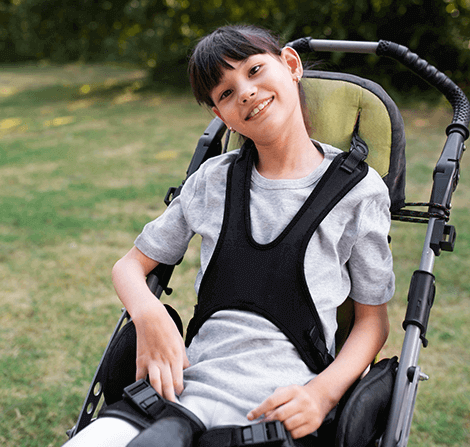Symptoms of Cerebral Palsy
The symptoms of Cerebral Palsy (CP) vary greatly depending on the type, severity, and areas of the brain affected. They typically appear in early childhood and can impact movement, muscle tone, posture, and other aspects of development. Below is a detailed explanation of common symptoms:
Movement and Muscle Control:
- Stiff or Tight Muscles (Spasticity): Difficulty in moving smoothly due to overly tense muscles.
- Involuntary Movements (Dyskinesia): Jerking, twisting, or writhing movements, often uncontrollable.
- Poor Balance and Coordination (Ataxia): Difficulty in maintaining balance, walking, or performing precise tasks like picking up objects.
Motor Skill Delays:
- Difficulty in achieving milestones such as rolling over, sitting, crawling, or walking at the expected age.
- Abnormal gait patterns, such as walking on toes, scissored walking, or dragging a leg.
Posture Issues:
- Challenges in sitting or standing upright due to weak or stiff muscles.
- Asymmetrical body alignment, where one side of the body is more affected than the other.
Muscle Tone Abnormalities:
- Hypertonia: Excessive muscle stiffness.
- Hypotonia: Reduced muscle tone, leading to floppy limbs or poor head control.
Oral and Speech Problems:
- Difficulty in speaking clearly due to weak facial or tongue muscles.
- Challenges in chewing or swallowing, increasing the risk of choking or drooling.
Reflex Abnormalities:
- Persistent infant reflexes (e.g., Moro reflex) that usually disappear as a child grows.
- Exaggerated reflex responses due to spasticity.
Associated Symptoms (Not Always Present):
- Seizures: In some cases, individuals may experience epilepsy.
- Vision or Hearing Impairments: Difficulty in seeing or hearing clearly.
- Intellectual Disabilities: Some may have learning difficulties, though many have normal intelligence.
- Pain or Discomfort: Due to muscle stiffness or joint issues.
- Joint Deformities: Over time, muscles pulling unevenly can cause skeletal issues like scoliosis or dislocated hips.
Severity Spectrum:
- Mild Symptoms: Slight clumsiness or stiffness, but capable of independent activities.
- Moderate Symptoms: May require assistive devices like braces or wheelchairs for mobility.
- Severe Symptoms: Extensive care needed for movement, daily activities, and communication.
The symptoms of CP are unique to each individual and may change over time, especially with therapy and interventions. Early detection and diagnosis can help in managing these symptoms effectively.
Treatment Options for Cerebral Palsy
While there is no cure for Cerebral Palsy (CP), various treatments can help manage symptoms and improve the quality of life. Below are the primary treatment options:
Therapies:
- Physical Therapy: Focuses on improving mobility, strength, and flexibility through exercises and stretching.
- Occupational Therapy: Helps develop self-care skills like dressing, eating, and using adaptive tools for independence.
- Speech Therapy: Aims to enhance communication skills, address speech difficulties, and manage swallowing issues.
Medical Management:
- Medications to relax stiff muscles, reduce pain, and control seizures or other associated conditions.
- Botulinum toxin (Botox) injections to reduce spasticity in specific muscles.
Assistive Devices:
- Mobility aids like wheelchairs, walkers, and crutches for improved movement.
- Orthopedic braces to support proper posture and alignment.
- Communication tools like speech-generating devices for individuals with severe speech impairments.
Surgical Interventions:
- Procedures to release tight muscles, improve joint alignment, or correct skeletal deformities.
- Selective Dorsal Rhizotomy (SDR) surgery to reduce spasticity by cutting specific nerve fibers.
With a combination of these treatments, individuals with Cerebral Palsy can achieve improved functionality and independence. Early intervention and a tailored care plan are essential for maximizing outcomes.
